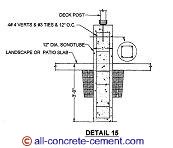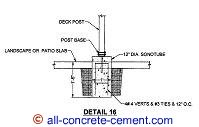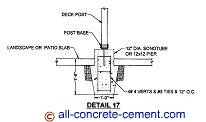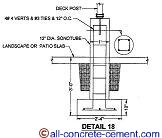|
[?]Subscribe To This Site
|
Ideas for Deck FootingsDeck footings, pier footings, column footings, and post footings can all describe the footing detail shown below for a deck. These footings can also be called spot footing or spread footing. This page provides different footing ideas that can be used for your deck. The main functions of footing are to transfer loads to the ground and stabilize the structure. For these reasons, footings for decks and houses are designed and detailed the same way.To save time and ease of detailing most designers use the details for house footings to apply at decks even though the load at deck is far less. Details 15, 16, 17 are most commonly used at footing for deck, post footings, and column footings.
Let’s examine the capacity of a 12 inch diameter pier footing as shown on detail 15. First we need to calculate the contact area of the deck post being the transfer point. Assuming 4x4 wood post, the area is 3.5x3.5 = 12.25 square inches. The formula to calculate the capacity of 4000 psi (pounds per square inch) concrete, is P/A = 4000 psi. Where P is the weight of whatever material and occupants intended to be put on the deck. The objective is to calculate the maximum weight that can be put on the deck without crushing the concrete pier. To solve for P, multiply the equation on both sides of the equal sign by the area. So P = 4000 x Area = 4000 x 12.25 = 49,000 pounds. It will take a whopping 49000 pounds before the concrete pier begins to break. To bring things into perspective, a suv weighs about 6,000 pounds. It will take 8 or 9 suvs parked on top of each other before the pier begins to break.
This time the contact area we need to calculate is the area of the pier A=πr^2 = π*6^2 = 113 square inches. The maximum P before the soil fails is P = 113 x 10.4 = 1175.2 pounds. As you can see it only takes 1175 pounds before the footing starts sinking further than where it is currently per detail 15. Let’s put a spread footing below the pier as shown in detail 18. The contact are A = 28 x 28 = 784 square inches. The maximum P will become 784 x 10.4 = 8153.6 pounds. By increasing the area of footing from 113 sq. in. to 784 sq. in., the load capacity jumped to about 7 times higher.Whether we are designing a spot footing, pier footing, column footing, post footing, or deck footings the process and detailing are almost identical. As shown in the above calculations, making the footings wider add to the stability and capacity of the structure. Back to deck footings Learn more concrete footing design concrete footing details |
|








 As demonstrated by the above calculation, it is more likely the soil will fail prior to the concrete. Let’s take a look at the load capacity of the soil. Assuming the soil pressure is 1500 psf = 10.4 psi (1500/144 to convert to square inches).
As demonstrated by the above calculation, it is more likely the soil will fail prior to the concrete. Let’s take a look at the load capacity of the soil. Assuming the soil pressure is 1500 psf = 10.4 psi (1500/144 to convert to square inches). 